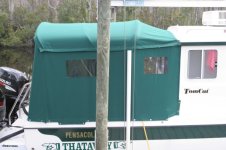Tom Hruby":3aa6pyps said:
Also, if you buy a standard bimini top, purchase one that is a bit wider than the cabin top with the frame slightly higher than the cabin top. That way you can bring the bimini top over the cabin and attach it to the railings with the webbing provided. That way the water will run off to the sides out of the cockpit. The best option however is to attach a 4-6 inch wide fabric with a zipper (overlap the top to prevent water ingress and apply a seam sealer) to the end of the bimini top. This strip can be attached to the top of the cabin in a variety of ways (glue, welt, velcro).
I differ on several issues here:
If a top is wider, it will not stop rain from entering the cockpit. Much of the time rain is accompanied by wind. The wind will blow the rain into the cockpit.
If you extend the Bimini frame over the entry area (the first 18" to 24" from the cabin Top--it can impede your entrance to the boat. You want a clear path of entry. I like a zip out/up panel there. If the Frame is high enough it may have less effect. Remember there is not a lot of room up there even in the best of Bimini's
I would never glue any canvas material to the top of the cabin. The proper method of securing any fabric to a cabin top is with an awning rail and bolt rope or snaps/Common Sense Fittings. Long term Velcro exposed to UV and salt elements does not do well.
Zippers need a bit more attention. You do not want corrosion. Buy the best you can find. A YKK #10 with molded Delrin teeth and pull have served me well in all of my boats. Smaller and or metallic parts will cause issues. There are silicone and teflon sprays for zippers which will make them easier to use and lengthen their useful lives.
You want at least 3 bows in the Bimini. Any less will allow sag and water pooling on the top.
If you look at the front of the photo in the first photo, you will see the flap which will over lap the zippers on front and back. You may want to use velcro on the underside this front flap to be sure it is water tight. (The Tom Cat is considerably faster than the 22, but in wind, water could enter even on a 22.)
The side panels will normally have the insect screens sewn in place. The clear vinyl will be zippered in. The top of the clear can be fixed or removable. In any case, make sheaths for the clear material out of terry cloth or sheet material, so it will not be scratched and avoids the distortion of rolled material. The side panels can be stowed flat under the V Berth.
You want the panels easy to remove. There are many ways to secure the Bimini forward against the aft end of the cabin top, if necessary to gain access around for your fishing.
Look at the flaps necessary to attach the forward and aft panels..if you buy a pre made Bimini, these will have to be added--and you don't want any more seams on top than necessary.
I made a camper "back" for my last 25, using ShelterRite PVC coated fabric (similar to what Inflatable boats are made of). I used no sewing and HL66, a vinyl material glue to assemble all of the components of the side and back curtain. No sewing; the clear vinyl is easily glued to the fabric. I did use Common Sense fittings for the top and sides instead of zippers, and used standard button snaps for the bottom and front to the cabin sides. It was done as an experiment--the only down side, is that the ShelterRite is heavier than Sunbrella. The cost for all materials was less than $500--and that would include "tools" necessary, including the snaps and "common sense" fittings.
There is a flap for the stern lines on the photos of finished. I intentionally made the side "view" small--and we used separate insect screens from the camper back. For "full privacy" we used light weight dark material to be hung on the inside of the clear vinyl.
I am including some photos of my Tom Cat Bimini. It allowed plenty of room for entrance, and the SS post allows you to steady yourself as you enter or leave the cockpit. The entire Bimini could be folded up and attached to the forward SS post on the first bow--and fixed there for fishing with Bungie cords..
We intentionally put in very small windows on the side, mainly for privacy at docks. We had almost fully clear vinyl on the back
In fitting stage--the front will have solid SS posts with quick release pins as does the back.

Completed camper back:



